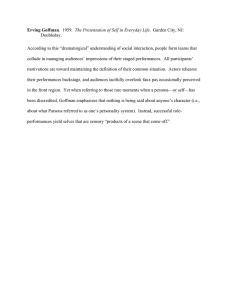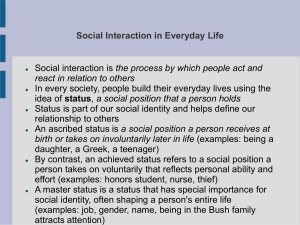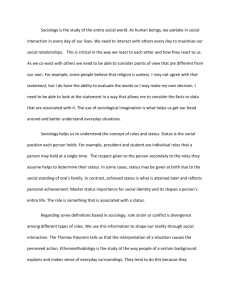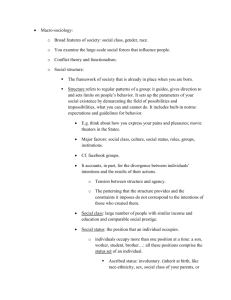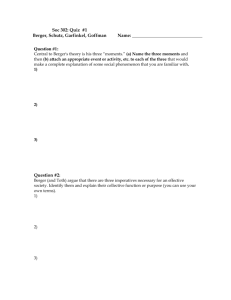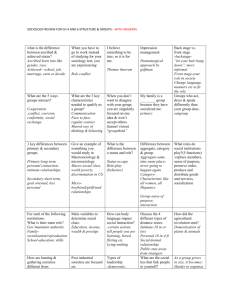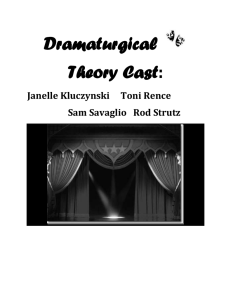Social Structure and Interaction in Everyday Life
advertisement
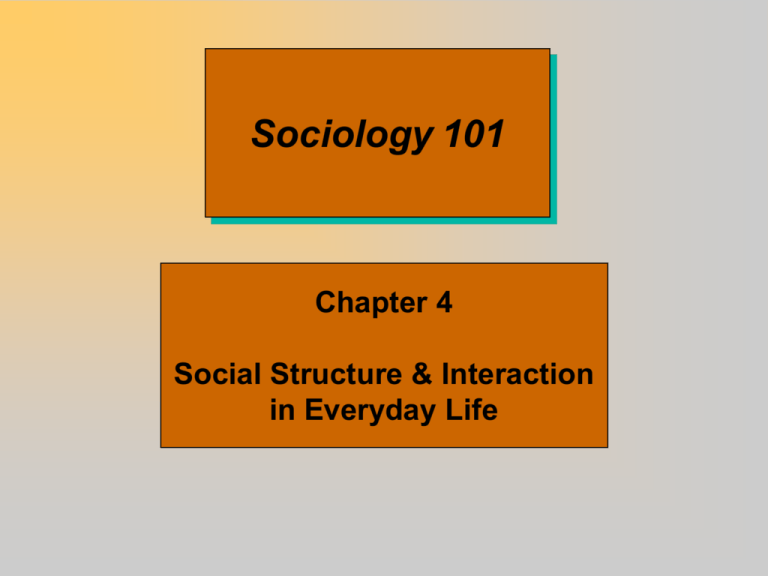
Sociology 101 Chapter 4 Social Structure & Interaction in Everyday Life Social Structure and Interaction Social structure is the framework of societal institutions (politics, and religion) and social practices (social roles) that make up a society and establish limits on behavior. Social interaction is the process by which people act toward or respond to other people and is the foundation for all relationships and groups in society. Social Structure Framework What Is Social Structure? Refers to the way in which society is organized It contains four elements: – a. – b. – c. – d. Statuses Roles Groups Institutions Status A socially defined position in a group (or society); accompanied by certain rights and duties Status Set - All of the statuses occupied by a person at one time Three Types of Status Ascribed - Conferred at birth or received involuntarily later in life Achieved - The result of choice, merit or effort Master - The most important status a person occupies ROLES A set of behavioral expectations that accompany a status. Role Conflict - Incompatible demands between multiple roles Role Strain - Incompatible demands within a single role GROUPS A number of people (more than one) who share similar norms, values and expectations or regularly and consciously interact. A gathering of multiple people is not necessarily a group: – Aggregate: A group of people who happen to be together – Category: A collection of people who have similar characteristics, but may not know one another Primary Groups Characteristics: – 1. – 2. – 3. – 4. – 5. Small Extended interaction Intimate/face-to-face contact Emotional ties Cooperative Secondary Groups Characteristics: –1. Larger –2. Temporary –3. Superficial –4. More Impersonal –5. More Formal Social Institutions A set of organized beliefs and rules that establishes how a society will attempt to meet basic social needs: – Family, Religion, Education, Government, and Economy The Functions of Social Institutions 1) Replace members 2) Socialize new members 3) Produce, distribute and consume goods and services 4) Preserve social order Social Structure and Modern Society Durkheim was interested in understanding this question: How do societies manage to hold together? Mechanical Solidarity Typical of Preindustrial Societies: – – – – Similar work Emphasis on group There are few social roles Social interaction is based on intimate social contact Organic Solidarity Greater division of labor Society is less personal People relate based on status and roles, not human qualities Interdependence is key Social Structure From the Macroperspective Functionalism – Social structure creates order and predictability in a society • We know what is expected of us and thus act accordingly which creates and maintains social order • Thus, social structure is functional for the maintenance of society Social Structure From the Macroperspective Conflict Theory – The way economic production is organized is the most important structural aspect of society • Social structure creates boundaries that define which persons or groups are “insiders” and which are “outsiders” – The Bourgeoisie vs. Proletariat • Thus, social structure is a source of conflict in society Social Structure From the Microperspective Social structure is based on shared understanding: – Social Constructionism (Peter Berger and Thomas Luckmann) – Ethnomethodology (Harold Garfinkle) – Dramaturgy (Erving Goffman) Peter Burger & Thomas Luckmann – Social Constructionism Social reality is a “social construction” – Our perception of reality is largely shaped by the subjective meaning that we give to our experiences • The Thomas Theorem: “If men define situations as real, they are real in their consequences” – We act on reality as we see it • Reality is what we believe it to be – Can lead to a Self-fulfilling prophecy: A false belief our prediction that produces behavior that makes the originally false belief come true Erving Goffman – Dramaturgical Analysis Erving Goffman – Dramaturgical Analysis – You are a collection of social roles (student, sister, athlete, etc.) – Daily interactions are similar to dramatic productions. – Members of our “audience” judge our performance and are aware that we may reveal our true character. – Most of us attempt to control the impressions we give to others. – We learn how to play our roles because others teach (socialize) us • others taught you how to be “a good student”, sorority member, etc.” – But how do we actually perform these roles? – Goffman argues that we assume roles much like a movie or stage actor – “All the world is a stage” • Frontstage • Backstage – Impression Management – Team work • Helps avoid embarrassing situations and maintains social order… – E.g. “The Party” Harold Garfinkle - Ethnomethodology – Sharing norms and rules of behavior provide: • Meaning • Social stability – The social order is challenged when these norms are broken – We see the underlying structure which holds society together when norms are broken • “Breaching experiments” – Breaching Experiments • • • • • • The professor Elevator... Store bartering... Boarders at home... Supermarket “borrowing”... Handing out change… Each of the above examples suggests: – That the norms governing and sustaining social order are taken for granted until challenged v Deference, politeness, and authority exist because they are taken for granted v These beliefs can be successfully challenged by people with sufficient power or self-assurance v That challenging the norms governing and sustaining social order creates chaos, embarrassment, frustration, and a breakdown in the social order
